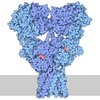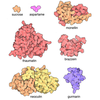+ Open data
Open data
- Basic information
Basic information
| Entry | Database: PDB / ID: 9nwo | |||||||||||||||||||||||||||||||||||||||
|---|---|---|---|---|---|---|---|---|---|---|---|---|---|---|---|---|---|---|---|---|---|---|---|---|---|---|---|---|---|---|---|---|---|---|---|---|---|---|---|---|
| Title | Human delta 2 receptor in the resting state | |||||||||||||||||||||||||||||||||||||||
 Components Components | Glutamate receptor ionotropic, delta-2 | |||||||||||||||||||||||||||||||||||||||
 Keywords Keywords | TRANSPORT PROTEIN / Ligand-gated ion channel / ion channel / neurotransmitter receptor | |||||||||||||||||||||||||||||||||||||||
| Function / homology |  Function and homology information Function and homology informationtrans-synaptic protein complex / cerebellar granule cell differentiation / positive regulation of long-term synaptic depression / excitatory synapse assembly / synaptic signaling via neuropeptide / regulation of postsynaptic density assembly / glutamate receptor activity / positive regulation of synapse assembly / heterophilic cell-cell adhesion / glutamate receptor signaling pathway ...trans-synaptic protein complex / cerebellar granule cell differentiation / positive regulation of long-term synaptic depression / excitatory synapse assembly / synaptic signaling via neuropeptide / regulation of postsynaptic density assembly / glutamate receptor activity / positive regulation of synapse assembly / heterophilic cell-cell adhesion / glutamate receptor signaling pathway / regulation of neuron projection development / parallel fiber to Purkinje cell synapse / AMPA glutamate receptor activity / AMPA glutamate receptor complex / ionotropic glutamate receptor complex / regulation of presynapse assembly / prepulse inhibition / regulation of postsynaptic membrane neurotransmitter receptor levels / regulation of neuron apoptotic process / excitatory postsynaptic potential / transmitter-gated monoatomic ion channel activity involved in regulation of postsynaptic membrane potential / synaptic transmission, glutamatergic / PDZ domain binding / postsynaptic density membrane / modulation of chemical synaptic transmission / intracellular protein localization / scaffold protein binding / dendritic spine / synapse / glutamatergic synapse / metal ion binding / identical protein binding / plasma membrane Similarity search - Function | |||||||||||||||||||||||||||||||||||||||
| Biological species |  Homo sapiens (human) Homo sapiens (human) | |||||||||||||||||||||||||||||||||||||||
| Method | ELECTRON MICROSCOPY / single particle reconstruction / cryo EM / Resolution: 3.57 Å | |||||||||||||||||||||||||||||||||||||||
 Authors Authors | Wang, H. / Ahmed, F. / Mondal, A.K. / Twomey, E.C. | |||||||||||||||||||||||||||||||||||||||
| Funding support |  United States, 1items United States, 1items
| |||||||||||||||||||||||||||||||||||||||
 Citation Citation |  Journal: Nature / Year: 2025 Journal: Nature / Year: 2025Title: Delta-type glutamate receptors are ligand-gated ion channels. Authors: Haobo Wang / Fairine Ahmed / Jeffrey Khau / Anish Kumar Mondal / Edward C Twomey /  Abstract: Delta-type ionotropic glutamate receptors (iGluRs, also known as GluDs) are members of the iGluR ligand-gated ion channel family, yet their function remains unknown. Although GluDs are widely ...Delta-type ionotropic glutamate receptors (iGluRs, also known as GluDs) are members of the iGluR ligand-gated ion channel family, yet their function remains unknown. Although GluDs are widely expressed in the brain, have key roles in synaptic organization, and harbour disease-linked mutations, whether they retain iGluR-like channel function is debated as currents have not been directly observed. Here we define GluDs as ligand-gated ion channels that are tightly regulated in cellular contexts by purifying human GluD2 (hGluD2) and directly characterizing its structure and function using cryo-electron microscopy and bilayer recordings. We show that hGluD2 is activated by D-serine and GABA (γ-aminobutyric acid), with augmented activation at physiological temperatures. We reveal that hGluD2 contains an ion channel directly coupled to clamshell-like ligand-binding domains, which are coordinated by the amino-terminal domain above the ion channel. Ligand binding triggers channel opening via an asymmetric mechanism, and a cerebellar ataxia point mutation in the ligand-binding domain rearranges the receptor architecture and induces leak currents. Our findings demonstrate that GluDs possess the intrinsic biophysical properties of ligand-gated ion channels, reconciling prior conflicting observations to establish a framework for understanding their cellular regulation and for developing therapies targeting GluD2. | |||||||||||||||||||||||||||||||||||||||
| History |
|
- Structure visualization
Structure visualization
| Structure viewer | Molecule:  Molmil Molmil Jmol/JSmol Jmol/JSmol |
|---|
- Downloads & links
Downloads & links
- Download
Download
| PDBx/mmCIF format |  9nwo.cif.gz 9nwo.cif.gz | 581.1 KB | Display |  PDBx/mmCIF format PDBx/mmCIF format |
|---|---|---|---|---|
| PDB format |  pdb9nwo.ent.gz pdb9nwo.ent.gz | 472.3 KB | Display |  PDB format PDB format |
| PDBx/mmJSON format |  9nwo.json.gz 9nwo.json.gz | Tree view |  PDBx/mmJSON format PDBx/mmJSON format | |
| Others |  Other downloads Other downloads |
-Validation report
| Summary document |  9nwo_validation.pdf.gz 9nwo_validation.pdf.gz | 1.4 MB | Display |  wwPDB validaton report wwPDB validaton report |
|---|---|---|---|---|
| Full document |  9nwo_full_validation.pdf.gz 9nwo_full_validation.pdf.gz | 1.4 MB | Display | |
| Data in XML |  9nwo_validation.xml.gz 9nwo_validation.xml.gz | 88.5 KB | Display | |
| Data in CIF |  9nwo_validation.cif.gz 9nwo_validation.cif.gz | 137.6 KB | Display | |
| Arichive directory |  https://data.pdbj.org/pub/pdb/validation_reports/nw/9nwo https://data.pdbj.org/pub/pdb/validation_reports/nw/9nwo ftp://data.pdbj.org/pub/pdb/validation_reports/nw/9nwo ftp://data.pdbj.org/pub/pdb/validation_reports/nw/9nwo | HTTPS FTP |
-Related structure data
| Related structure data |  49888MC  9nwpC  9nwqC  9oooC  9oopC M: map data used to model this data C: citing same article ( |
|---|---|
| Similar structure data | Similarity search - Function & homology  F&H Search F&H Search |
- Links
Links
- Assembly
Assembly
| Deposited unit | 
|
|---|---|
| 1 |
|
- Components
Components
| #1: Protein | Mass: 94287.391 Da / Num. of mol.: 4 Source method: isolated from a genetically manipulated source Source: (gene. exp.)  Homo sapiens (human) / Gene: GRID2, GLURD2 / Production host: Homo sapiens (human) / Gene: GRID2, GLURD2 / Production host:  Homo sapiens (human) / References: UniProt: O43424 Homo sapiens (human) / References: UniProt: O43424Has protein modification | Y | |
|---|
-Experimental details
-Experiment
| Experiment | Method: ELECTRON MICROSCOPY |
|---|---|
| EM experiment | Aggregation state: PARTICLE / 3D reconstruction method: single particle reconstruction |
- Sample preparation
Sample preparation
| Component | Name: Human Delta-2 Receptor / Type: COMPLEX / Entity ID: all / Source: RECOMBINANT |
|---|---|
| Molecular weight | Experimental value: NO |
| Source (natural) | Organism:  Homo sapiens (human) Homo sapiens (human) |
| Source (recombinant) | Organism:  Homo sapiens (human) Homo sapiens (human) |
| Buffer solution | pH: 8 |
| Specimen | Embedding applied: NO / Shadowing applied: NO / Staining applied: NO / Vitrification applied: YES |
| Vitrification | Cryogen name: ETHANE |
- Electron microscopy imaging
Electron microscopy imaging
| Experimental equipment |  Model: Titan Krios / Image courtesy: FEI Company |
|---|---|
| Microscopy | Model: TFS KRIOS |
| Electron gun | Electron source:  FIELD EMISSION GUN / Accelerating voltage: 300 kV / Illumination mode: FLOOD BEAM FIELD EMISSION GUN / Accelerating voltage: 300 kV / Illumination mode: FLOOD BEAM |
| Electron lens | Mode: BRIGHT FIELD / Nominal defocus max: 2500 nm / Nominal defocus min: 900 nm |
| Image recording | Electron dose: 45 e/Å2 / Film or detector model: FEI FALCON IV (4k x 4k) |
- Processing
Processing
| EM software | Name: PHENIX / Version: 1.21.1_5286 / Category: model refinement | ||||||||||||||||||||||||
|---|---|---|---|---|---|---|---|---|---|---|---|---|---|---|---|---|---|---|---|---|---|---|---|---|---|
| CTF correction | Type: PHASE FLIPPING AND AMPLITUDE CORRECTION | ||||||||||||||||||||||||
| 3D reconstruction | Resolution: 3.57 Å / Resolution method: FSC 0.143 CUT-OFF / Num. of particles: 87597 / Symmetry type: POINT | ||||||||||||||||||||||||
| Refinement | Highest resolution: 3.57 Å Stereochemistry target values: REAL-SPACE (WEIGHTED MAP SUM AT ATOM CENTERS) | ||||||||||||||||||||||||
| Refine LS restraints |
|
 Movie
Movie Controller
Controller







 PDBj
PDBj

